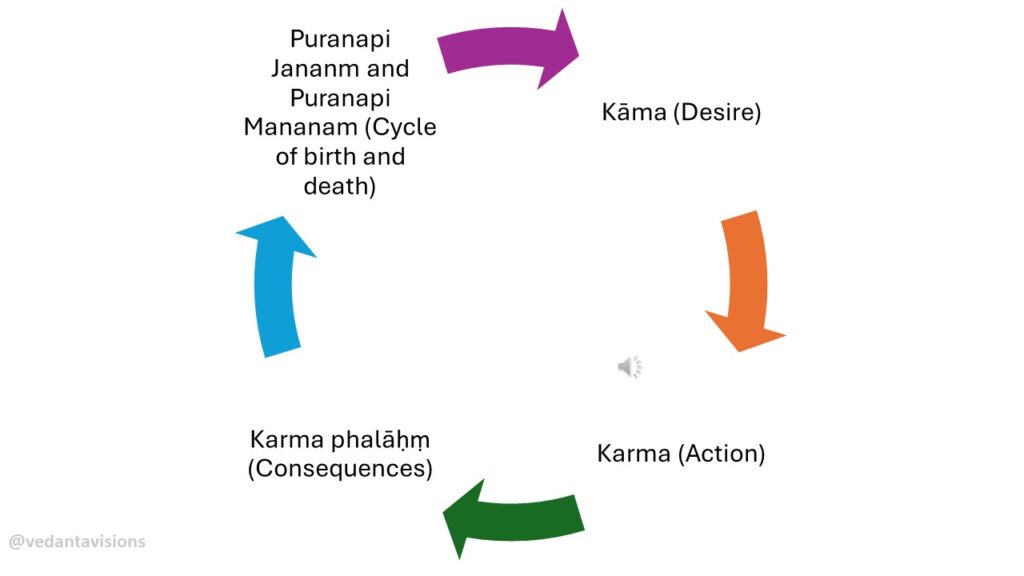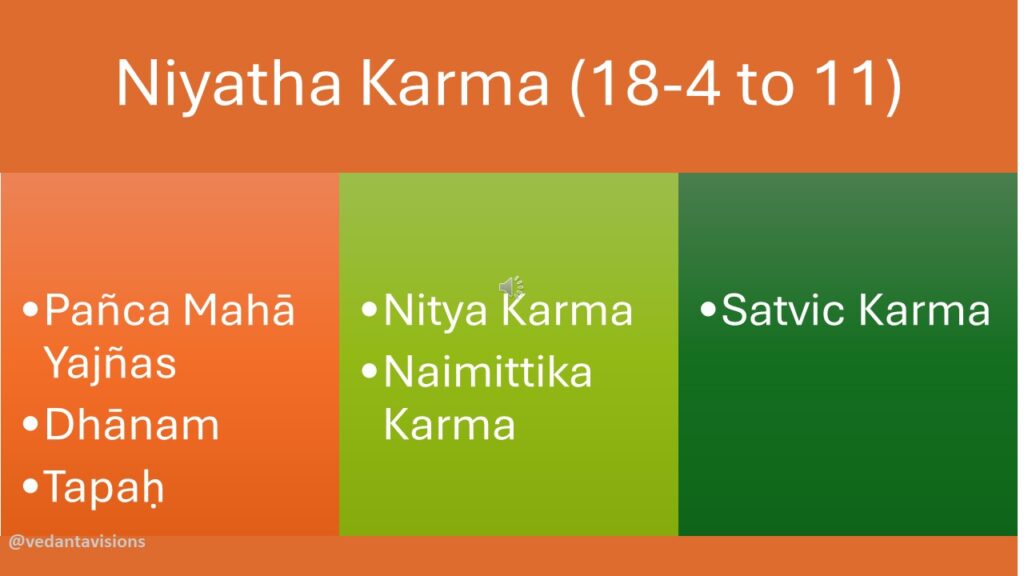Bhagwat Geeta, Class 186 – Chapter 14 Verses 19 and 20
Each guna binds a person in one way or another, because each guna requires a particular set up. Satva guna requires a setup conducive to knowledge and tranquility, rājo guna requires a setup conducive to activity and tāmo guna requires a setup conducive to sleep. A particular set up that is favorable for sattva guna, is not favorable for rājo guna. As a boktha we divide the set up into favorable and unfavorable, developing strong rAga and dveSha. To change the set up, we become a kartA. But the setup is never satisfactory, so we constantly try to change the setup. But we never own by our infinite nature. SaguNa body mind complex keeps us so busy that we are not allowed to think of nirguNa sakshi. The three guNas constantly change, requiring constant change in the setup, resulting in a person being in eternal struggle. The only remedy is transcending the three gunas and ahamkara. AhaMkAra can never be made nirguNa as the three guNas are bound to be there. NirguNa mind does not exist, as mind is subject to the three guNas. The only remedy is to switch the identification from SaguNa ahaMkAra to nirguNa consciousness.
Consciousness is beyond the body, but it is not physically beyond. Consciousness is not affected by body mind complex, even though it is in and through the body. This is similar to light is in and through an object, but it is not affected by the object. The disturbances of the mind do not affect the consciousness. I am that consciousness, beyond the three guNas and not affected by the body mind complex. The day I know that my pUrNatvam is not determined by the setup is the day I am free. An intelligent person changes himself rather than changing the setup.
AnAtma is the doer. To emphasize this, Lord Krishna says that there is no doer other than anAtma. Only when we recognize this fact, we will be free from the struggles of life. This is jivanmukti and this can be obtained only by knowledge or jñānam.
Verse 20
Having gone beyond these three gunas which are the cause of rebirth, a person becomes free from birth, death, old age, and sorry and attains immortality.
Three guNas represent the three bodies, five koshas and the entire anatma. This body is a given by the lord, for gathering the knowledge that I am the body, but I have the body for temporary use. The three guNas have given me this body, they will also give me my next body. The three guNas are the cause of repeated acquisition of bodies. When a person disidentifies form the body, that person is free from all the problems belonging to the body. Body is mortal is not a problem; but I am mortal is problem. Vedanta does not remove the idea that the body is mortal but teaches that I am not the mortal body but the immortal I, the atma behind the mortal body. The body being born, growing, decaying and dying are not a problem; it is the nature of the body. It becomes a problem for sorrow when I refuse to accept that nature. ShAkShi jñānam gives me objectivity with regards to my own body. Once this objectivity comes, the intensity of the problem comes down. The body will have to go through the condition, but you develop a different perspective and the events of life may not appear to be a tragic events. This is similar to the sunlight making the stars as though they do not exist.
JIvan mukti is making life’s problem insignificant by changing the perspective through knowledge. As a result of this knowledge, the mortality of body is not a problem. We can attain immortality by shifting the identification from the mortal body to immortal atma. This is jivan mukthi and also called guNatheetha.
Verse 21
Arjuna asked – Oh Lord! With what characteristics does a person who is beyond these three guNas appear? What is his conduct? And how does he go beyond these three guNas?
Arjuna is inspired by the Lord’s teachings and asks three questions:
- The first question is what are the characteristics or indicators of a person who has transcended the three guNas? Will there be any change in his physical body? Will there be any extraordinary powers?
- The second question is how does he conduct himself and interact with other people?
- The third question is how does he transcend the three guNas? Is it a physical journey?







